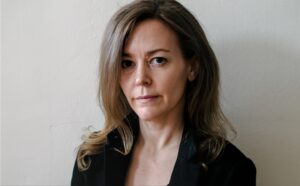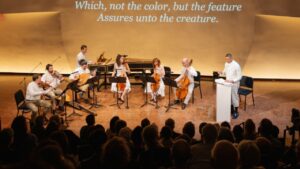
The Frick Collection Concert Season 2025-26 Review: Sonnambula, Ensemble-in-Residence; Davóne Tines, Bass-Baritone
By Jennifer Pyron(Photo: Lawrence Sumulong)
The Frick Collection Concert season 2025-26 Ensemble-in-Residence, Sonnambula, debuted on Sunday, November 2, 2025 in collaboration with pioneering bass-baritone Davóne Tines. Tines made his Met Opera debut last year in John Adams’s “El Niño” and released his first studio album through Nonesuch Records, “DAVÓNE TINES & THE TRUTH’S ‘ROBESON,'” which premiered at NYC’s Little Island in 2024. His work as a creator, curator, and performer challenges racist practice in early music and beyond. The evening’s program, “A Black Masque,” was inspired by “The Masque of Blackness” (1605), a collaboration between poet Ben Jonson (1572-1637), designer Inigo Jones (1573-1652) and composer Alfonso Ferrabosco II (1575-1628).
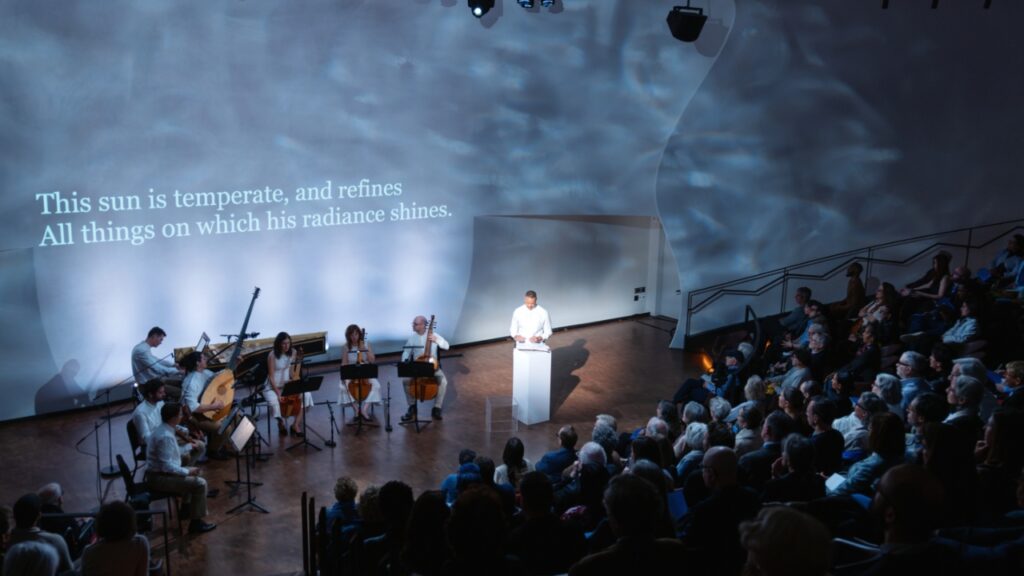
(Photo: Lawrence Sumulong)
Concert Details
The historically-informed ensemble, Sonnambula, includes Jude Ziliak (violin), Toma Iliev (violin), Elizabeth Weinfield (viola da gamba/direction), Amy Domingues (viola da gamba), Matt Zucker (viola da gamba), Dušan Balarin (lute and theorbo), and James Kennerley (harpsichord). They are the inaugural ensemble-in-residence for NYC’s The Frick Collection, in its newly renovated Stephen A. Schwarzman Auditorium, which features an intimate and modern setting made perfect for every seat in the house. The walls are a soft egg-shell cream in color and while seating is limited to approximately 200, it is like a cocoon. Listeners can bathe in the brilliance of every note and dynamic. The soft leather bucket seats for every audience member are also a thoughtful touch, making it easy for one to sit back and relax. The gentle architectural folds that outline the main stage area are neatly tucked back into themselves like the gentle opening of a newly blossomed flower. The sound resonates from stage center and fills the entire space, making it possible for the listener to rotate their head or even sit backwards and still receive the highest quality experience. This is immersive listening in its highest form.
The program notes for this debut concert read as follows: “Sonnambula opens its 2025–26 residency with a performance inspired by Ben Jonson’s Masque of Blackness (1605), an allegorical court entertainment commissioned by Queen Anne of Denmark and originally staged at the Jacobean court. Featuring music by Alfonso Ferrabosco II (only one song of which survives), the masque depicts African nymphs journeying to England to seek racial purification, reflecting early modern England’s racial anxieties and imperial fantasies. Sonnambula, joined by acclaimed bass-baritone Davóne Tines, interweaves instrumental works by Ferrabosco and William Byrd — representing the masque’s lost musical context — with recitations from medieval West African griot sagas such as The Epic of Sundiata and The Epic of Kele Monzon. These tales passed down by West African storytellers (griots) assert the power of oral tradition in preserving historical memory and cultural identity. Through this juxtaposition, the performance quietly unsettles Jonson’s masque, inviting reflection on the contrasting roles of music and storytelling in shaping histories and identities.”

(Photo: Lawrence Sumulong)
Musical Highlights
The concert opened with a large-font text displayed on the back wall of the stage with details about “The Masque of Blackness.” The Sonnambula ensemble were seated and began the musical journey with a William Brade (1560-1630) pavane and galliard. The quality of sound from this moment on was on another level – the Frick’s renovation is a celebration of sound!
The ensemble played with excitement and curiosity, diving head first into the finest details of early music, revealing their careful and in-depth excavation of the historical context. Davóne Tines entered from stage right and walked to stage left, where a display pedestal with cover featured a book of loose papers. He lifted the cover and set it aside, while taking his time to examine the book’s pages. Tines observed the ensemble, audience, and back wall of the stage where the text captioned the words before he began reading out loud. Initially, the text was following in line with his pace — however there were moments that it became too fast and so it was best to focus on Tines and experience his meaningful gestures as he performed.
Tines exudes an intelligence that even precedes his performances. I find myself in awe of his ability to share his discoveries with such ease and confidence. He faces racism head on and is unlimited in his compassion and awareness. His art making is something real. His greatest gift is the natural grace he embodies and how he delivers what many are still trying to process when considering how opera and early music will “survive.” Tines bridges opera and traditional music’s multi-generational gap. He is the remembrance of what has been lost along the way and the celebration of what is to come.
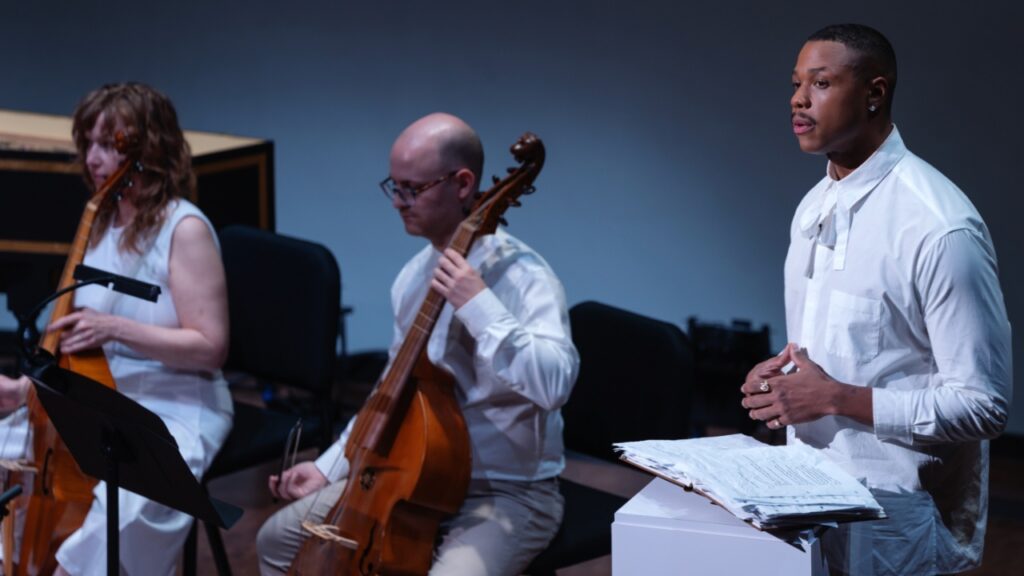
(Photo: Lawrence Sumulong)
His performance began with reading from the book’s papers and describing the “The Masque of Blackness” in detail, including descriptions of guests in attendance, ornate costuming, fantastical sea creatures according to mythology, and court members. His voice sounded incredibly beautiful in the space, very clear and resonate in its articulation. He was immersed in what he was sharing and this made audience members feel at ease and open to listening and imagining along with him. All of this was while Sonnambula played Ferrabosco II’s “Alman.”
Tines then began singing “Sound, Sound Aloud,” with text by Jonson, and “The Silver Swan” by Orlando Gibbons (1583-1626). His full bodied bass-baritone was perfect for the space and lightness of the ensemble’s playing. I observed audience members swaying to the joyful music and imagined a court of dancers and magnificent chandeliers before me. This was early music at its finest.
Tines spoke of Oceanus approaching in great sadness as the ensemble performed John Dowland’s (1563-1626) “Lachrimae Coactae.” The lament placed a lingering veil of mystery and grief upon the light mood. It added a new palette of tonal colors to adorn the evening and created depth with its delivery. Sonnambula’s tone and expressive legato lines were delicious.
Tines then began the dialogue about Niger, Oceanus, and Aethiopia with text by Jonson’s “The Masque of Blackness.” The moment that stood out the most in this was the description of Britannia and how all the sea creatures and gatherers of this land would be welcomed together: “This sun is temperate, and refines, all things on which his radiance shines.”
Sonnambula followed this reading with William Lawes’ (1602-1645) “Royal Consort Set No. 1 in D Minor: Corant and Saraband.” The Saraband especially was luscious and ripe with expressivity. This made for a seamless introduction to Ferrabosco II’s “Come Away, Come Away” from “The Masque of Blackness.” Tines spoke before he sang about how this was sung while the characters danced on shore and this was a call to him. His voice’s lower register was met with the ensemble’s levity and they played along in harmony together. Tines’ dynamics were utilized the most in this and featured a simple ornamentation at the end.
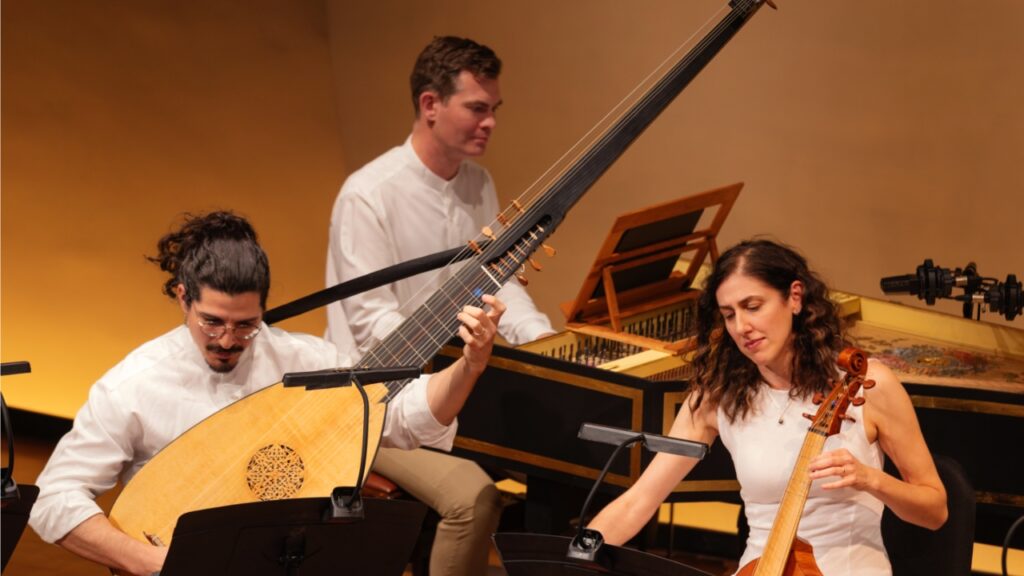
(Photo: Lawrence Sumulong)
The characters continued in their dance and the ensemble played Anthony Holborne’s (1545-1602) “The Honiesuckle” and “The Night Watch.” Both were delightful and playful in tone. Sonnambula’s chemistry when playing together is historical in its own right. They transport one to another realm entirely!
Brade’s “Flower Dance” and “Scottish Dance” were performed next. The evening shifted into a sensuous and satiating mood of romantic bliss. Again, audience members rocked in their seats as they listened to and enjoyed every note together. This led listeners towards the most tender moment of all. The characters ended their dance and became separated as they slowly parted from the masque.
John Coprario’s (1570-1626) “So Parted You” was performed with two violins played at opposite sides of the auditorium, enveloping the audience with their echos. Tines and Sonnambula member Balarin performed in duet while the violinists, Ziliak and Iliev, echoed in response. Each call and response drew into a stillness and quiet that made the night absolutely unforgettable.
The most notable takeaway from this evening was how the program invited listeners to experience the new Stephen A. Schwartzman Auditorium in all its glory through sound. This is the power of music and its universal language that dissolves all barriers. Bravissimo to everyone who made this possible!
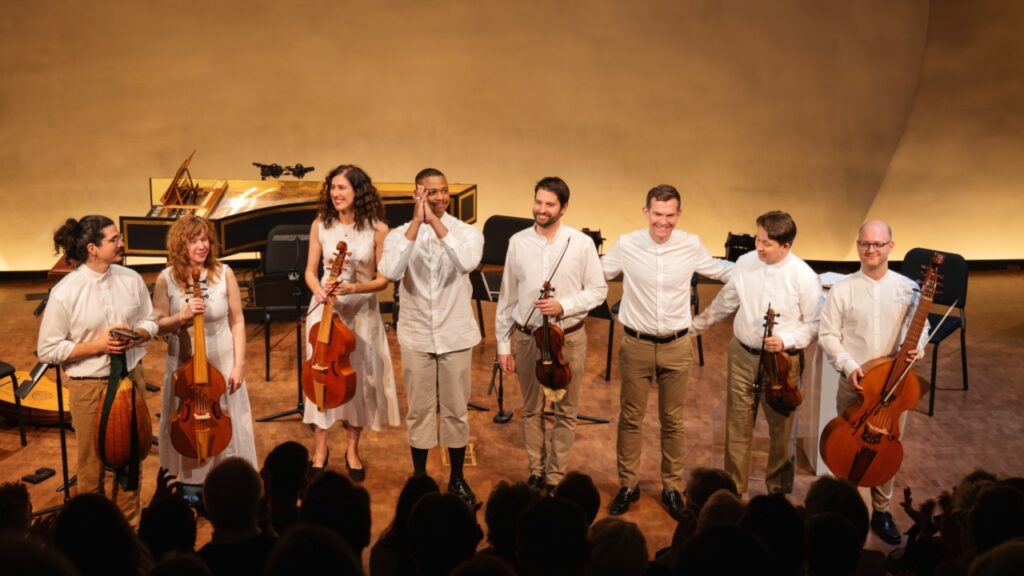
(Photo: Lawrence Sumulong)
